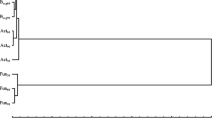Abstract
The introduction of Trichoderma viride spores (108 CFU per 1 cm2) essentially changed the structure of micromycetes in the soils of tree nurseries in Krasnoyarsk region. During the first 20 days, in the variants with dark gray forest soils and podzolized chernozems, the total number of fungi decreased by 3–4 and 1.5 times, respectively, as compared to that in the control plots. During the intense development of the introduced microbes, the species composition of the soil fungi changed considerably. The treatment of Scots pine seeds with metabolites of Trichoderma fungi, as well as Pseudomonas and Bacillus bacteria, in the form of water suspensions, biopreparations, and dry spores promoted an increase in the yield of seedlings and improve their morphometric parameters. At the end of the growing period, the treatment with Trichoderma and the biopreparation on its basis increased these parameters, on average, by 18–70%, and the treatment with bacteria increased the same parameters by 13–15%. The application of microbial preparations improved the phytosanitary state of the soils in the studied tree nurseries. The use of the strains of indigenous microorganisms might be feasible for solving bioremediation problems more successfully in particular regions.
Similar content being viewed by others
References
E. V. Arinushkina, Handbook on the Chemical Analysis of Soils (Mosk. Gos. Univ., Moscow, 1970) [in Russian].
O. A. Berestetskii and S. P. Nadkrechechnyi, “Fungi Producing Phytoxicants in the Soil under Continuous Culture and Crop Rotation Conditions,” in Phytotoxic Properties of Soil Microorganisms (VNIISKhM, Leningrad, 1978), pp. 94–104 [in Russian].
L. L. Velikanov and I. I. Sidorova, “Ecological Problems of Plant Protection from Diseases,” Itogi Nauki Tekhn. Zashch. Rast. 6, 141 (1988).
Yu. M. Voznyakovskaya, “Interactions of Plants with Microorganisms of the Rhizophere and Phyllosphere,” in Agronomical Microbiology (Kolos, Leningrad, 1976), pp. 144–179 [in Russian].
M. V. Gorlenko, “Some Directions of Evolution of Phytopathogenic Fungi,” Mikol. Fitopatol. 29(1), 87–94 (1995).
T. G. Dobrovol’skaya, L. V. Lysak, and D. G. Zvyagintsev, “Soils and Microbial Diversity,” Pochvovedenie, No. 6, 699–704 (1996) [Eur. Soil Sci. 29 (6), 630–634 (1996)].
T. G. Dobrovol’skaya, I. Yu. Chernov, and D. G. Zvyagintsev, “Structural Parameters of Bacterial Communities,” Mikrobiologiya 66(3), 408–414 (1997).
B. A. Dospekhov, Procedure of Field Experiments with Basic Statistical Processing of Results (Agropromizdat, Moscow, 1985) [in Russian].
D. G. Zvyagintsev, T. G. Dobrovol’skaya, and L. V. Lysak, “Plants as Development Centers of Bacterial Communities,” Zh. Obshch. Biol. 54(3), 183–200 (1993).
D. G. Zvyagintsev, T. G. Dobrovol’skaya, L. M. Polyanskaya, and I. Yu. Chernov, “Theoretical Bases of the Ecological Assessment of Soil Microbial Resources,” Pochvovedenie, No. 4, 65–73 (1994).
A. I. Ivanov, “Effect of Simazine on the Nutritional Regime of Soil,” Agrokhimiya, No. 3, 113–115 (1974).
S. A. Illarinov, A. V. Nazarov, and I. G. Kalachnikova, “The Role of Micromycetes in the Phytotoxicity of Oil-Contaminated Soils,” Ekologiya, No. 5, 341–346 (2003).
O. P. Kovylina, Extended Abstract of Candidate’s Dissertation in Agriculture (Krasnoyarsk, 1990).
M. A. Litvinov, Guide to Microscopic Soil Fungi (Nauka, Leningrad, 1967) [in Russian].
Methods of Soil Microbiology and Biochemistry, Ed. by D. G. Zvyagintsev (Mosk. Gos. Univ., Moscow, 1991) [in Russian].
Bergey’s Manual of Determinative Bacteriology, Ed. by J. A. Holt et al. (Williams and Wilkins, Baltimore, 1994).
E. P. Popova, Nitrogen in Forest Soils (Nauka, Novosibirsk, 1983) [in Russian].
G. Sh. Seiketov, Trishoderma Fungi and Their Practical Use (Nauka, Alma-Ata, 1982) [in Russian].
E. E. Yakimenko, “Soil Micromycetes of Forest Nurseries,” Mikol. Fitopatol. 26(6), 480–486 (1992).
E. E. Yakimenko and I. D. Grodnitskaya, “Infectious Lodging of Coniferous Seedlings in Forest Nurseries of Krasnoyarsk Krai,” Mikol. Fitopatol. 30(2), 56–60 (1996).
E. E. Yakimenko and I. D. Grodnitskaya, “Effect of Trishoderma Fungi on Soil Micromycetes Causing the Infectious Lodging of Coniferous Seedlings in Forest Nurseries of Siberia,” Mikrobiologiya 69(6), 850–854 (2000).
I. D. Grodnitskaya and E. E. Yakimenko, “Agrochemical and Microbiological Properties of Soil within a Forest Nursery in the South of Krasnoyarsk Region,” Eur. Soil Sci. 29(10), 1162–1168 (1996).
Author information
Authors and Affiliations
Additional information
Original Russian Text © I.D. Grodnitskaya, N.D. Sorokin, 2007, published in Pochvovedenie, 2007, No. 3, pp. 359–364.
Rights and permissions
About this article
Cite this article
Grodnitskaya, I.D., Sorokin, N.D. Application of microbes to the soils of Siberian tree nurseries. Eurasian Soil Sc. 40, 329–334 (2007). https://doi.org/10.1134/S106422930703012X
Received:
Issue Date:
DOI: https://doi.org/10.1134/S106422930703012X




